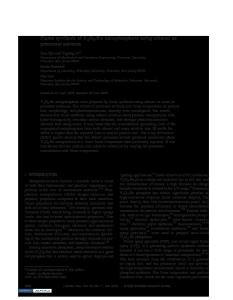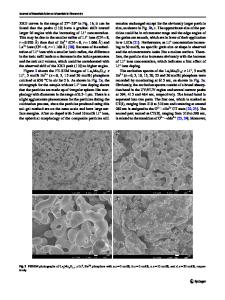Luminescent properties of Y 2 O 3 :Eu 3+ nanophosphor prepared from urea added precursor using flame spray pyrolysis
- PDF / 856,279 Bytes
- 5 Pages / 584.957 x 782.986 pts Page_size
- 86 Downloads / 277 Views
Madhav B. Ranade Particle Engineering Research Center, University of Florida, Gainesville, Florida 32611 (Received 2 October 2008; accepted 18 May 2009)
Y2O3:Eu3+ nanophosphor was synthesized by flame spray pyrolysis (FSP) from urea added nitrate based liquid precursor. In this study, urea serves as fuel and subsequently provides additional heat in the flame zone during the synthesis of phosphor particles. The end product shows cubic phase Y2O3:Eu3+ nanophosphor successfully prepared by FSP without heat treatment. The influence of synthesis conditions such as different mol of urea and nitrate source materials in aqueous solution, and doping concentration on luminescent properties, were investigated. The characteristics of nanophosphor such as crystallinity and morphology under various experiments of conditions were carried out by x-ray diffraction (XRD) and field emission-scanning electron microscopy (FE-SEM). The particle size of product was found to be in the range of 20–30 nm from transmission electron microscopy (TEM). In photoluminescence (PL) properties, Y2O3:Eu3+ nanophosphor emitted red light with a peak wavelength of 609 nm when excited with 398 nm wavelength photons. I. INTRODUCTION
Phosphor materials are widely used in high quality optical display and lighting devices. Especially, europium doped yttrium oxide is one of the most popular phosphor materials in red light emitting applications.1 Recently, the use of nanometer size phosphors has become an attractive idea in high resolution displays because it has great potential in lighting applications with high efficiency.2,3 Many studies were focused on crystallinity, morphology, luminescent properties, and concentration quenching of nanoscale phosphors with different synthesis methods and conditions. The decrease in phosphor particle size to the nanometer range increases the surface-to-volume ratio and also the quantum efficiency.4 Moreover, a smaller phosphor size could result in a smaller screen pixel size and a higher degree of transparency for phosphors dispersed in other substrates. The luminescent efficiency of phosphors for lighting applications is usually related to emission efficiency, concentration quenching, and size and morphology of phosphors.5,6 The requirements for improving the efficiency of phosphor materials are based on the high quality of the host materials, and reducing concentration quenching. Also spherical and dense morphology of phosphors are required to get better photoluminescent characteristics.6 Therefore, it is necessary to make phos-
phors with higher luminescence efficiency and in the nanometer-size range. Many different types of techniques such as sol-gel method,7 hydrothermal synthesis,8 co-precipitation,9 and combustion10 have already been applied to generate phosphor particles. Among these methods, FSP is a powerful method and has a simple process for making particles in the nanometer range. The advantage of FSP compared to conventional methods is the possibility of using a wide range of precursors and liquid fuels su
Data Loading...











